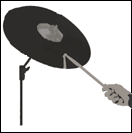Percussion Lesson: Beginner Drum Lesson Part 2
Now we've learnt the basics of music notation and rhythm, we're ready to start our first piece.
Try to play the following example on the snare drum. Don't forget to count the different note-values, as shown.
The letters over the notes tell you which hand to use:
Adding the Ride Cymbal We're now going to play the ride cymbal and the snare drum together.
The ride cymbal is played with the tip of the drum-stick, about 6-8cm in from the edge, as shown:
Using your right hand to play the ride, and your left to play the snare, now try the following rhythm: (with a four beat intro)
We're now going to play the ride cymbal and the snare drum together.
The ride cymbal is played with the tip of the drum-stick, about 6-8cm in from the edge, as shown:
Using your right hand to play the ride, and your left to play the snare, now try the following rhythm: (with a four beat intro)
Adding the Bass Drum There are two main ways to play the bass drum - which one you choose is totally a matter of preference.
It's simply a minim note, played on the cymbal.
Time to Groove We're now ready to put the elements we've learnt so far together into our first real drum groove. We've covered quite a lot in this lesson, so now might be a good time to review what you've learnt so far. The standard rock beat we'll now learn could be considered the basis of all rock drumming. Master this and you're well on your way. Practise it very slowly at first. Once you get good, you can speed it up a little. GOOD LUCK!
- L - left hand
- R - right hand
Adding the Ride Cymbal
 We're now going to play the ride cymbal and the snare drum together.
The ride cymbal is played with the tip of the drum-stick, about 6-8cm in from the edge, as shown:
Using your right hand to play the ride, and your left to play the snare, now try the following rhythm: (with a four beat intro)
We're now going to play the ride cymbal and the snare drum together.
The ride cymbal is played with the tip of the drum-stick, about 6-8cm in from the edge, as shown:
Using your right hand to play the ride, and your left to play the snare, now try the following rhythm: (with a four beat intro)Adding the Bass Drum There are two main ways to play the bass drum - which one you choose is totally a matter of preference.
- The first option is to keep the foot flat on the pedal at all times, moving only the
ankle to press down the pedal.
- The second option is to rest only the ball of the foot on the pedal and 'stamp' the pedal down using the whole leg.

It's simply a minim note, played on the cymbal.
Time to Groove We're now ready to put the elements we've learnt so far together into our first real drum groove. We've covered quite a lot in this lesson, so now might be a good time to review what you've learnt so far. The standard rock beat we'll now learn could be considered the basis of all rock drumming. Master this and you're well on your way. Practise it very slowly at first. Once you get good, you can speed it up a little. GOOD LUCK!




